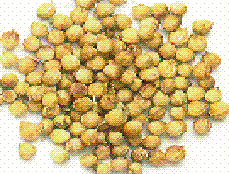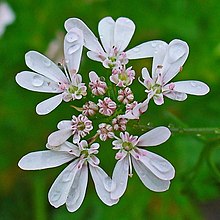
These roasted and dried seeds are used both as whole and in powdered form. They have a distinct warm, sweet aroma that blends especially well with chili and garlic.Coriander Powder
Fruit
The dry fruits are known as coriander seeds or coriandi seeds. In some regions, the use of the word coriander in food preparation always refers to these seeds (as a spice), rather than to the plant itself. The seeds have a lemony citrus flavour when crushed, due to the presence of the terpenes linalool and pinene. It is also described as warm, nutty, spicy, and orange-flavoured. They are usually dried but can be eaten green.
If the spice is bought (or picked -- it can be grown in a home garden) whole in a non-dried form, it can be dried in the sun. Most commonly, it is bought as whole dried seeds, but can also be purchased in ground form. When grinding at home, it can be roasted or heated on a dry pan briefly to enhance the aroma before grinding it in an electric grinder or with a mortar and pestle; ground coriander seeds lose their flavour quickly in storage and are best only ground as needed. For optimum flavour, whole coriander seed should be used within six months, or stored for no more than a year in a tightly sealed container away from sunlight and heat.
Coriander seed is a key spice (Hindi name: ????? dhania) in garam masala and Indian curries, which often employ the ground fruits in generous amounts together with cumin. It also acts as a thickener. Roasted coriander seeds, called dhana dal, are also eaten as a snack. It is also the main ingredient of the two south indian gravies: sambhar and rasam.
Outside of Asia, coriander seed is an important spice for sausages in Germany and South Africa (see boerewors). In Russia and Central Europe coriander seed is an occasional ingredient in rye bread as an alternative to caraway. Apart from the uses just noted, coriander seeds are rarely used in European cuisine today, though they were more important in former centuries.
Coriander seeds are also used in brewing certain styles of beer, particularly some Belgian wheat beers. The coriander seeds are typically used in conjunction with orange peel to add a citrus character to these styles of beer.
Coriander is believed to have originated in the Mediterranean area, and in southwest Europe. Some believe its use began as far back as 5,000 BC, and there is evidence of its use by the ancient Egyptians. In the Bible, Exodus, chapter 16, verse 31, it says "And the house of Israel began to call its name Manna: and it was white like coriander seed, and its taste was like that of flat cakes made with honey".
Thought to have been introduced to Britain by the Romans as a meat preserver, coriander seems to have been cultivated in Greece since at least the second millennium BC. In Linear B tablets, the species is referred to as being cultivated for the manufacture of perfumes, and it appears that it was used in two forms: as a spice for its seeds and as a herb for the flavour of its leaves. This appears to be confirmed by archaeological evidence from the same period: the large quantities of the species retrieved from an Early Bronze Age layer at Sitagroi in Macedonia could point to cultivation of the species at that time (Fragiska, 2005).
Coriander seed and leaf was very widely used in medieval European cuisine, due to its ability to make spoiled meats palatable by "masking" rotten flavours. Even today, coriander seed is an important ingredient in many sausage products.
Coriander was brought to the British colonies in North America in 1670 and was one of the first spices cultivated by early settlers.
Health effects & medicinal uses
Coriander, like many spices, contains antioxidants, which can delay or prevent the spoilage of food seasoned with this spice. A study found both the leaves and seed to contain antioxidants, but the leaves were found to have a stronger effect.
Chemicals derived from coriander leaves were found to have antibacterial activity against Salmonella choleraesuis, and this activity was found to be caused in part by these chemicals acting as nonionic surfactants.
Coriander has been used as a folk medicine for the relief of anxiety and insomnia in Iran. Experiments in mice support its use as an anxiolytic. Coriander seeds are used in traditional Indian medicine as a diuretic by boiling equal amounts of coriander seeds and cumin seeds, then cooling and consuming the resulting liquid. In holistic and traditional medicine, it is used as a carminative and as a digestive aid.
Coriander has been documented as a traditional treatment for diabetes. A study on mice found that coriander extract had both insulin-releasing and insulin-like activity.
Coriander seeds were found in a study on rats to have a significant hypolipidemic effect, resulting in lowering of levels of total cholesterol and triglycerides, and increasing levels of high-density lipoprotein. This effect appeared to be caused by increasing synthesis of bile by the liver and increasing the breakdown of cholesterol into other compounds.
Coriander juice (mixed with turmeric powder or mint juice) is used as a treatment for acne, applied to the face in the manner of toner.[citation needed]
Coriander can produce an allergic reaction in some people.
| < Prev | Next > |
|---|

